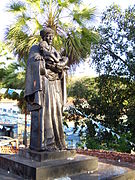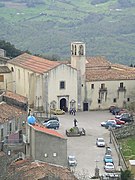Benedict the Moor
Saint Saint Benedict of Palermo O.F.M. | |
|---|---|
 Stained glass of Saint Benedict the Moor, inside of the Capela do Divino Espírito Santo, Porto Alegre, Brazil. | |
| Religious and confessor | |
| Born | 1526 San Fratello, Messina, Sicily, Crown of Aragon |
| Died | 4 April 1589 (aged 62–63) Palermo, Sicily, Crown of Aragon |
| Venerated in | Catholic Church (Sicily and the Franciscan Order) Lutheranism |
| Beatified | 1734 by Pope Benedict XIV |
| Canonized | 24 May 1807 by Pope Pius VII |
| Major shrine | Church of the Gesù, Palermo, Italy |
| Feast | 4 April (3 April in the Franciscan Order) |
| Patronage | African missions; African Americans; black missions; black people; Palermo; San Fratello; Sicily |
Benedict the Moor O.F.M. (Template:Lang-it; 1526 – 4 April 1589) was a Sicilian Franciscan friar who is venerated as a saint in the Catholic[1] church. Born of enslaved Africans in San Fratello, he was freed at birth and became known for his charity. As a young man he joined a Franciscan-affiliated hermit group, of which he became the leader. In 1564 he was sent to the Franciscan friary in Palermo, where he continued good works.
Life
Benedict was born to Cristoforo and Diana Manasseri, Africans who were taken as slaves in the early 16th century to San Fratello (also known as San Fradello or San Philadelphio), a small town near Messina, Sicily. They were given Italian names and later converted to Christianity. The Italian "il Moro" for "the dark-skinned" has been interpreted as referring to Moorish heritage. Because of his appearance, Benedict was also called Æthiops or Niger (both referring to black skin color and not the modern-day countries).
Benedict's parents were granted freedom for their son before his birth because of their "loyal service". Like most peasants, Benedict did not attend any school and was illiterate. During his youth, he worked as a shepherd and was quick to give what he had earned to the poor.[2] When he was 21 years old, he was publicly insulted for his color. His forbearance at this time was noted by the leader of an independent group of hermits on nearby Monte Pellegrino, who followed the Rule for hermit life written by Francis of Assisi. Benedict was quickly invited to join that community, and shortly thereafter he gave up all his earthly possessions and joined them. He served as the cook for the community and at the age of twenty-eight succeeded Jerome Lanze as leader of the group.[3]
In 1564 Pope Pius IV disbanded independent communities of hermits, ordering them to attach themselves to an established religious Order, in this case, the Order of Friars Minor. Once a friar of the Order, Benedict was assigned to Palermo to the Franciscan Friary of St. Mary of Jesus. He started at the friary as a cook, but, showing the degree of his advancement in the spiritual life, he was soon appointed as the master of novices, and later as Guardian of the community, although he was a lay brother rather than a priest, and was illiterate.
Benedict accepted the promotion, and successfully helped the order adopt a stricter version of the Franciscan Rule of life. He was widely respected for his deep, intuitive understanding of theology and Scripture, and was often sought for counseling. He also had a reputation as a healer of the sick. Combined, these characteristics continued to draw many visitors to him. As he enjoyed cooking, he returned to kitchen duty in his later years.[2]
Benedict died at the age of 65 and, it is claimed, on the very day and hour which he had predicted. At the entrance of his cell in the Franciscan friary of St. Mary of Jesus, there is a plaque with the inscription: "This is the cell where Saint Benedict lived", and the dates of his birth and death – 1524 and 1589. Other sources list the year of his birth as 1526.[2] In a New York Times review of the 2012 exhibit, Revealing the African Presence in Renaissance Europe, at the Walters Art Gallery in Baltimore, Maryland, his birth date is given as 1526.[4]
Upon his death, King Philip III of Spain ordered the construction of a magnificent tomb to house his remains in the friary church.[5]
Veneration
Benedict was beatified by Pope Benedict XIV in 1743 and canonized in 1807 by Pope Pius VII. It is claimed that his body was found incorrupt upon exhumation a few years later.
Benedict is remembered for his patience and understanding when confronted with racial prejudice and taunts. He was declared a patron saint of African Americans,[6] along with the Dominican lay brother, Martin de Porres. In the United States, at least seven historically Black Catholic parishes bear his name, including but not limited to the following cities:
| Parish name | Diocese | Location | Canonically established | |
|---|---|---|---|---|
| St. Benedict the Moor | Archdiocese of Washington | Washington, D.C., USA | 1946 | [7] |
| St. Benedict the Moor | Archdiocese of New York | New York City, USA | [8] | |
| St. Benedict the Moor | Archdiocese of Kingston | Bull Bay, Jamaica | ||
| St. Benedict the Moor | Archdiocese of Cincinnati | West Dayton, Dayton, Ohio, USA | 2005/2020 | [9] |
| St. Bonaventure - St. Benedict the Moor | Diocese of Brooklyn | Jamaica, Queens, New York City, USA | 1932 | [10] |
| St. Benedict the Moor parish | Diocese of Pittsburgh | Pittsburgh, USA | 1889/2020[11] | [12] |
| St. Benedict the African parish | Archdiocese of Chicago | Englewood, Chicago, USA | 1989/2016^ | [13][14] |
| St. Benedict The Black | Diocese of Shreveport | Grambling, Louisiana, USA | ||
| St. Benedict the Moor, Bertrandville | Diocese of Baton Rouge | Bertrandville, Louisiana, USA | 1911 | [15] |
| St Benedict the Moor, Savannah | Diocese of Savannah | Savannah, Georgia, USA | 1888 | [16] |
The latest church in the United States to be placed under his patronage is the one in Dayton, established in 2003 under the leadership of Fr Francis Tandoh, a priest from Ghana. The parish maintains a ministry to natives of that country, as well as parishioners from two previous parishes merged to form it.[17]
St. Benedict the Moor Catholic Church, established in 1874 and located in the Historical District of Savannah, Georgia, is the oldest Catholic Church for African Americans in Georgia and one of the oldest in the Southeastern United States. Churches named for him have also been founded in Columbus, Georgia and St. Augustine, Florida.[18]
Veneration of Benedict is spread throughout Latin America, from Mexico through Argentina. In Venezuela, particularly, his devotion is spread through the country's various states, and he is celebrated on many different dates, according to the local traditions.
Gallery
-
Statue of Saint Benedict the Moor (c.1734) at the National Gallery of Art's showing of Afro-Atlantic Histories in 2022
-
Altar of Saint Benedict the Moor in the Basilica of Saint Francis, Lima, Peru
-
Statue of Saint Benedict the Moor in Cuiabá, Mato Grosso, Brazil
-
San Fratello, Sicily — the sanctuary of Saint Benedict and the Convent of Saint Francis
-
18th century intaglio print of Saint Benedict
-
Saint Benedict the Moor Church and Rectory, Saint Augustine, Florida, US
-
Saint Benedict the Moor Church, Pittsburgh, Pennsylvania, US
See also
References
- ^ St. Benedict at EWTN.com. Retrieved 2010-06-28.
- ^ a b c Venable, Cecelia Guiterrez. "St. Benedict the Moor (1526-1589)", BlackPast.org
- ^ "Black Saints: Benedict the Moor", National Catholic Reporter, November 18, 2013
- ^ Cotter, Holland. "A Spectrum from Slaves to Saints", The New York Times, 9 November 2012, pp. C21 and C28
- ^ "St. Benedict the African". AmericanCatholic.org.
- ^ Foley O.F.M., Leonard. "St. Benedict the African", Saint of the Day, (revised by Pat McCloskey O.F.M.), Franciscan Media
- ^ "About". St. Benedict the Moor. Retrieved 2022-05-29.
- ^ Rajamani, Maya (September 18, 2017). "1st Northern Church for Black Catholics Should Be Saved, Not Sold: Board". DNAinfo New York. Archived from the original on 2019-12-05. Retrieved 2022-05-29.
- ^ "St. Benedict the Moor Parish and West Dayton's Black Catholic Community". Catholic Telegraph. Retrieved 2022-05-29.
- ^ "Chronological List of Queens Parishes, 1843-2009" (PDF). Diocese of Brooklyn.
- ^ "Bishop David Zubik Accepts Proposal, Establishes Personal Parish for the Black Catholic Community". Catholic Diocese of Pittsburgh. Retrieved 2022-05-29.
- ^ Catholic News Agency. "Priests share hope for new Pittsburgh parish in Black Catholic tradition". Catholic Telegraph. Retrieved 2022-05-29.
- ^ "About - St. Benedict the African (There's a Sweet Sweet Spirit in this Place)". benedicttheafrican.org. Retrieved 2022-05-29.
- ^ Weldon, C. Michael (2004). A Struggle for Holy Ground: Reconciliation and the Rites of Parish Closure. Liturgical Press. ISBN 978-0-8146-2155-4.
- ^ "St. Benedict the Moor, Bertrandville". Roman Catholic Diocese of Baton Rouge. Retrieved 2022-05-29.
- ^ "Our Parish". St Benedict the Moor Catholic Church. Retrieved 2022-06-08.
- ^ "About Us". St. Benedict the Moor Catholic Church. Retrieved April 3, 2013.
- ^ "Archived copy". Archived from the original on 2011-06-17. Retrieved 2010-06-28.
{{cite web}}: CS1 maint: archived copy as title (link)
Further reading
- Attwater, Donald and Catherine Rachel John. The Penguin Dictionary of Saints. 3rd edition. New York: Penguin Books, 1993. ISBN 0-14-051312-4.
- St Benedict the Moor Church in Dayton, Ohio. On February 2, 2003, the parish community of St. James/Resurrection broke ground on eleven acres of property at the corner of Liscum Drive and McLin Parkway (State Route 35). St. Benedict the Moor celebrated on May 14, 2005, the opening of their church and the "homecoming" of a faith journey that started many years ago .
External links
- StBenedicttheMoor.org
- Saints.SQPN.com: St Benedict Biography
- Anja's Art: St. Benedict Wood Sculpture
- 1526 births
- 1589 deaths
- People from San Fratello
- Italian hermits
- Italian Friars Minor
- Burials in Sicily
- Sicilian saints
- Canonized Roman Catholic religious brothers
- People celebrated in the Lutheran liturgical calendar
- 16th-century Christian saints
- Franciscan saints
- Incorrupt saints
- Canonizations by Pope Pius VII
- Religious leaders from the Province of Messina
- African diaspora in Italy
- African-American Roman Catholicism
- Beatifications by Pope Benedict XIV
- Lutheran saints







